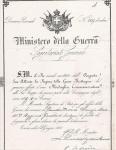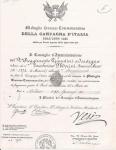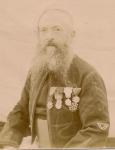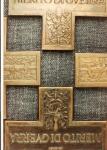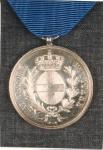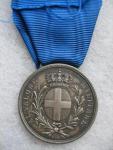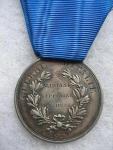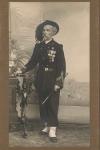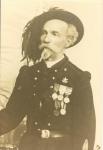
tjnier
For Deletion-
Posts
35 -
Joined
-
Last visited
Content Type
Profiles
Forums
Blogs
Gallery
Events
Store
Everything posted by tjnier
-
The Cross of Merit of War - Italian Medal
tjnier replied to djg145's topic in The Great War 1914 to 1918
Dave: It turns out that your CSM William Woodhead also won the Mlitary Medal !! Woodhead's award of the Italian War Merit Cross appears in the London Gazette of 17 May 1919, page 6208. He is listed as "15421 Company Serjeant-Major William Woodhead, M.M.,12th Battalion, Durham Light Infantry. (Castleford, Yorks.). Castleford would have been his residence at the time of his enlistment, when he was assigned his regimental service number 15421. Now you need to inquire where the Woodhead M.M. is located today. Also, you can find his M.M. award in the London Gazette by checking through its name indexes, especially those for the period 1917-1919. Best wishes andr good luck in your research!! --- Tom Nier -
Italy Italy - British Crimean medal to Sardinian Troups
tjnier replied to Veteran's topic in Southern European & Balkan States
http://gmic.co.uk/uploads/monthly_08_2014/post-8573-0-73908800-1408981768.jpghttp://gmic.co.uk/uploads/monthly_08_2014/post-8573-0-75227300-1408981786.jpgAttached is an example of the Sardinian brevetto (= certificate) for the British Crimea medal. It is made out to "Grenadier Francesco Mario Morini, 2nd Regt. of Sardinian Genadiers." Attached also is Morini's brevetto for the French medal for the Italie 1859 campaign. By then, Morini had become a Drummer (Tamburino) in the 2nd Regt. -
Uncategorised Order of the Black Star
tjnier replied to blackthorn's topic in The Great War 1914 to 1918
The Great War produced a high demand for French decorations for the Allies fighting alongside French Troops. Whereas the Allies had or expanded their series of military decorations, the French had only the Legion of Honor. In order to preserve the prestige of the LOH, various junior French orders were pressed into service, being awarded outside of their original purpose and context. These included the Black Star, the Academic Palms, the Agricultural Merit, and the Medals of Honor from the various French ministries. Thus the LOH could be reserved for the most outstanding services rendered, or for award to just the most senior officers. Lesser degrees of service, and lower ranking officers were placated with these other decorations. -
The Cross of Merit of War - Italian Medal
tjnier replied to djg145's topic in The Great War 1914 to 1918
Hello Dave: The simple answer is that the 12th Durham Light Infantry served in Italy from November 1917 up to Austria's armistice on 4 Nov. 1918. After the disastrous Italian defeat at Caporetto, a joint British-French force was sent to support the Italian front against further Austrian gains. A search of the London Gazette has located 758 awards of the Italian War Merit Cross to British personnel. -
Hello Veteran: Many thanks for your analysis of this interesting photograph, especially the identification of the hunting horn at the elbow of his sleeve as a marksmanship badge. I re-examined the three stripes under a hand lens. They all have the same dimensions, herringbone weave, and shade of gray (which suggests the same color). Would this indicate a sergeant's rank, or were re-enlistment stripes identical to rank stripes in size and color?? In the bend of the bottom chevron is a flaming bomb, and immediately below it is a crossed pair of single blade axes. The axes should confirm his status as a Sapper, which is reflected in his full beard and what appears to be his leather apron around his waist. The weakest evidence is what appears to be a shoulder tag along the upper seam of his sleeve with the jacket. Under a hand lens, a few letters appear to my eye which fall into the legend "legion etrangere". But my eye may be deceiving me. I would gladly mail this photograph to a GMIC member who is an expert on French Army uniforms, for an independent opinion. Can anyone recommend such an expert??
-
Hendrik: Thanks for your insight about the "Italie 1859" medal possibly being the Italian Independence Wars medal. However, the Independence medal is usualy observed with one or more dated clasps which indicated the veteran's specific campaign(s). I can't detect any clasps on this man's medal. Chris: This veteran may well have served in another unit of the French Army. I take it that the posthorn insignia visible at his left elbow implies that he had served in the Chasseurs a pied ou monte?
-
Sometimes one can derive considerable information about a veteran by studying his photograph. Attached is a portrait of such a French Army veteran, with a close-up of his medals. He wears the Legion of Honor, Chevalier, and the Medaille Militaire, both Third Republic models. Next is a colonial medal with two rectangular clasps. The fourth medal on his top row appears to be the 1870-71 War Medal. The bottom row shows what looks to be the Italie 1859 medal, followed by the 5th class badge of the Tunisian Order of Nichan Iftikhar. His left shoulder sleeve insignia has the three chevrons of a Sergent-Chef, or Senior Sergeant. Using a hand lens,a crossed pair of single blade axes is visible right below the chevrons. So this soldier had served in one of the elite Sapper units of the French Army. Their hazardous duty won them the privileges of having a full beard, wearing a leather apron & gloves, and carrying the axe instead of a rifle.when on parade. The wide light band around this veteran's waist is his leather apron. Additional study of this veteran's upper sleeve next to the jacket seam, revealed enough letters to identify the shoulder tag "LEGION ETRANGERE". So this man was a veteran of a Sapper unit of the Foreign Legion. His photo had to have taken sometime after 1911, the year of institution of the 1870-71 medal. Assuming he served in the Italie 1859 campaign at the age of 18, his birth year would be 1841. Thus he would have been about age 70 when he sat for his photograph by 1911.
-
Italy Al Valore Militare after 1945
tjnier replied to dedehansen's topic in Southern European & Balkan States
You may be interested to know that Journal OMSA will be publishing my in-depth article on the Al Valore MIlitare medals. I am told it is scheduled for the May-June 2013 issue. The article covers AVM varieties dating from 1849 to World War 1. Regards to all, Tom Nier -
Italy- Unusual Cross for military valour
tjnier replied to tjnier's topic in Southern European & Balkan States
While there is so much interest in the War Merit Cross varieties, I have another question for the Club members. I have examples of the WMC each with one of several hallmarks on the lower reverse arm, placed near the lower right corner. These include the crown over Z mark of the Royal Mint, which specimen was awarded to a British Artillery Major in WW1. The other single letter hallmarks known to me include "M", "R". "F" struck in relief, and "B" incused into the Cross. Does anyone have a clue as to the meaning of these letter hallmarks?? Are there more letter hallmarks known to be or observed on the WMC?? One theory bandied about is that they represent manufacture in Rome, Milan, Firenze, and Bologna. However, my Italian contacts say they have never heard of this theory. They suspect the letters correspond to local firms making the Crosses, not to the cities of manufacture. Would be glad to receive any new information on this subject from the Club members. Many thanks, Tom -
Italy- Unusual Cross for military valour
tjnier replied to tjnier's topic in Southern European & Balkan States
I apolgize for my delay in reply to the question of the actual ribbon on the AVM cross with the "Xa" stamped over the VE III monogram. The ebay listing in March 2011 showed that it had a plain blue ribbon. I did not win this eBay item. Many thanks to the Club members who provided so much information about this unusual AVM Cross. -
The topic of BWM awards to European civilians was discussed by Anthony Margrave in his quarterly journal on French medals titled "Honneur et Patrie, October 1997, Vol. 6, #3, pages 24-26 (this journal is now discontinued). He quoted a reference that 4127 British War Medals were awarded to British, Belgian & French civilians who worked as agents for the BEF in France during the war. These names were in a record box titled "British War and Victory medals. Agents, British, Belgian, French" which was housed at the Public Records Office, Kew, as Record Group 329/2356. The French recipients were in a manuscript dated 7 August 1919, which consisted of 17 typed pages. It listed the names and addresses of the French civilians, men & women entitled to the BWM. There was a note in the record box stating that 269 BWMs for French citizens were to be named, and 9 more were to be left blank. Alec Purves in his book "Medals, Decorations & Orders of the Great War 1914-1918" stated that 133 silver and 573 bronze BWMs were awarded to European civilians who aided the BEF in France. None of these medals were named as issued, according to Purves. An article by Marcel Nuikttens on the BWM awards to Belgian citizens was published in the Winter 1991 issue of Journal OMRS, Vol. 30, #4, pages 181-283.
-
Italy - Italian traslation please
tjnier replied to army historian's topic in Southern European & Balkan States
I obtained this 1950 photograph from a dealer in Argentina. Some his medals are too obscure to be examined under a lens, but most of them can be identified. The top row of 3 consists of an unknown cross, a War Merit Cross, and a WW! Commemorative medal with two clasps. The second row of 4 contains a WW1 Victory meda, a United Italy medal, an obscured medal, and a very prominent Third Army cross. The bottom row has only one obscured medal. The unknown cross in the 1st row reminds me of the Order of St.John of Jerusalem. Its member medal has a black ribbon. -
Here is an unusual variety of the Italian Cross of Military Valor. It appeared in an eBay auction that closed on 3-27-2011. What is different is that the King's monogram "VE" on the upper reverse arm has been overstamped with a large "X" and a small "A" (in the upper right corner). It came in a fitted maroon case with the Cravanzola hallmark printed on the inside of its lid. The seller believed that this mark represented its award to a member of the elite 10th MAS. This was an Italian Navy group of commandos that manned human torpedoes against British warships, and performed other daring activities in WW2. It was also suggested that this overstamp indicated the abdication of the Italian King after the Italian surrender to the Allies in 1943. Does any GMIC member have a correct explanation of this interesting overstamp??
-
The official issue of the 1870 Independence medal has the die designer's name "CANZANI" struck in relief on both faces. It appears right below the bust of King VE II at his neckline. It also appears below the toga & shield of the female figure on the reverse. I have seen privately struck varieties of this medal, particularly ones with the "S.J." hallmark of Stefano Johnson placed near the obverse edge at about 5 o'clock. The early versions of the dated laurel spray clasps have a thick round silver wire backstrap. These silver clasps are struck fairly thin & hollow. Clasps of later vintage have a thin flat silver wire band for the backstrap.
-
Belgium Question of Order of Leopold I
tjnier replied to Tim B's topic in Northern European & Baltic States
One clue that may help analyse your two Leopold I Order varieties is examining the green enamel of the wreath. My very limited experence with WW1 versus WW2 models of this badge has noted two distinct types of "green" enamel. MY WW1 Knight's badge (with a silver "A" palm) has a yellow green enamel. My WW2 Officer's badge (with a gilt "L" palm) has a visibly blue green enamel. Moreover, this blue green enamel fluoresces under a black light, whereas the yellow green enamel does not. Early post-WW2 awards of this order's badge may have been made with the blue green enamel, which may have been corrected later to the traditional yellow green enamel. Your Officer's Leopold I badge appears to have blue green enamel, while your Knight's badge looks to have yellow green enamel. -
Italy - War Merit Cross varieties
tjnier replied to tjnier's topic in Southern European & Balkan States
It's curious but I have another such War Merit Cross in the exact same case. The WMC went through several transitions in the 1920s. The addition of the "FERT" sword apparently indicated the WMC was awarded for junior acts of bravery not rating the bronze Al Valore Militare. Later the "Merito di Guerra" legend on the cross reverse was replaced with "Al Valore Militare" for this same purpose. And the blue with 2 white stripes ribbon was eventually replaced with the plain blue AVM ribbon on this AVM cross. So the Al Valore Militare series now had gold, silver, & bronze medals, plus a bronze AVM cross. Perhaps the GMIC members in Italy can give a more authoritative description of these post-WW1 changes in the WMC. -
IMHO you have a better and much scarcer Nap III China 1860 medal, compared to the usual Barre model. Sacristain examples appear to be harder to find than even the Falot or E.F. (Farochon) examples. I have a Mexico 1862-63 medal by Sacristain. I was very lucky to find it, and plunked down a stiff price for it without hesitation. One significant difference in the Sacristain obverse die is the very narrow spacing between NAPOLEON and III. The Barre, Falot, and Farochon obverse dies show a much wider spacing between the Emperor's name and III.
-
This impressive set of ribbon bars recently came from London, UK, via eBay. I searched the website "British Army Officers -- 1939-1945", but could not find any decent match-up. This officer may have reached the rank of Colonel by the end of WW2 to have rated a CB. His DSO & MC/bar may be WW1 awards. His OBE was a Civil award, and the MID on his GSM is rather uncommon. Do the GMIC members have any suggestions as to how to identify this unusual combination of ribbons?? Perhaps there is a book about the British 8th Army's service in North Africa, which also contains a list of senior officers?? Any leads would be greatly appreciated.
-
For some years, I have been recording numbered US DFCs that have passed through the collectors' market place. My survey now totals 92 DFC numbers. Numbers above about 1500 up to 13022 appear stamped on the left bottom edge. The five digits were then split around the bottom propeller tip, as shown by your medal. These split numbers range from 13x166 up to 18x032. This supply of numbered DFCs is believed to have been exhausted early in WW2. So far, these DFC numbers have not been found attributed in WW2 Air Corps records.
-
Italy - The Italian earthquake medal 1908
tjnier replied to Great Dane's topic in Southern European & Balkan States
Franco Scandaluzzi's book (1962) describes the medal with 2 white side stripes as the "merit" medal for those rendering relief to the victims of 1908. The other medal with 3 white stripes was given to British Royal Navy personnel who actually landed at Messina to give immediate aid to the survivors. It often appears named along its rim in RN medal groups. See "Angels in Blue Jackets - The (Royal) Navy at Messina, 1908", by J.W. Wilson & R. Perkins (1985). Perhaps the merit medal was intended for those who donated funds or relief materiel without visiting Messina?? Maybe your Dane did both? -
Belgium Decoration Militaire Belgium
tjnier replied to g_deploige's topic in Northern European & Baltic States
Here is a "sleeper" Decoration Militaire recently acquired on eBay at a very reasonable price. It was emphatically described as a Leopold III version, but its picture clearly showed it was a Leopold II medal. When received, it turned out to be the design of 1900-1910. The points of the bottom cross arm are bent upward, and its ring is deformed, but it is a finely struck cross with crisp details. Would the Club members agree that its reverse center most closely resembles Guy Depoige's type IV??. Is the later Leopold II medal (1900-10) more difficult to find, compared to the Albert and Leopold III medals?? -
The Italian War Merit Cross was instituted in January 1919. By 1927, over one million had been awarded (Klietmann). There were four categories of qualification for the WMC (Purves). 1 - A act of bravery not warranting the Al Valore Militare. 2 - A promotion for a mention for war merit. 3 - A wound received in combat. 4 - At least one year of combat service. Purves' book on WW1 awards mentions that "several varieties of the cross exist, but those struck at the Rome Mint have a small R on the reverse of the lower arm." Illustrated are four hallmarked varieties of the WMC, all showing the mark at the lower arm reverse, to the right of the sword handle. The top example has the crowned "Z" for the Royal Mint in Rome. The left cross has an "R". The right specimen has a "B", and the bottom cross has an "M". I have a fifth variety (not shown) marked with an "F". The "B" has been found incused (stamped) into several WMC examples, while the other marks (crown Z, R, M, & F) are observed to be die struck in relief. It has been believed that these letter hallmarks represent some major Italian cities that manufactured these WMC. The letter marks have been interpreted: R = Roma, M = Milano, B = Bologna, & F = Firenze (Florence). It has been assumed that these marks were soon discontinued due to the demand for a large supply of the crosses. Do any of the GMIC members have more definite information on these WMC hallmarks?? Are there additional letter hallmarks that I'm not aware of??
-
This is a very early Al Valore Militare medal with the "F.G" hallmark. It is fitted with a ball & ring suspension instead of the more familiar staffa used on later AVM medals. It is beautifully engraved around the rim "GUERRA DELL'INDIPENDENZA ITALIANA - SFORZESCA E NOVARA - 21 E 23 MARZO 1849" Its center is engraved to "DULFUS / Bne. BOLESLAS / SOTTOTENENTE / NELL 1o REGGo / DI FANTa". I apologize for my scans being affected by the light reflection off the medal surfaces. Novara was one of the first battles fought by the Sardinians against Austria in the Risorgimento (emergence) of the Italian nation. It was a defeat which forced the abdication of King Charles Albert in favor of his son Victor Emmanuel II. But the Savoy dynasty earned the moral victory, and a reputation which made it the leader of Italy's national hopes. I believe "Bne." is a title of nobility, meaning "Baron" Dulfus. That surname (cognomen) sounds more Hungarian rather than Sardinian or Italian. Perhaps Dulfus was a refugee from Austria-Hungary who had no love for the Hapsburgs. Would any GMIC member have additional information about this junior officer??
-
Attached are scans of an Al Valore Militare engraved to a French Captain Mariani of the 6th Hussars. This medal recently emerged from an old collection that had been in storage for years. Some biography can be obtained for French Army officers who served in the 19th century. Hyacinthe Joseph Louis Mariani was born 7 November 1827 in upper Corsica. He was commissioned 2nd Lieutenant in the 6th Hussars in December 1854, which regiment did not serve in the Crimea. The 6th Hussars did fight at Solferino in 1859 with over 60 casualties, and received 20 AVM from the Italians. The French Army Annual Directory ("Annuaire Officiel") for 1868 lists him as Captain, 6th Hussars as of December 1857, and holding the Legion of Honor, grade of Chevalier. In the 1870 War with Germany, Mariani was promoted to Major (Chef d'Escadrons) with the 8th Cuirassiers. This regiment fought heroically, with nearly 300 killed or wounded.
-
Italy - 2 Brevets - British Crimea medal &
tjnier replied to tjnier's topic in Southern European & Balkan States
Ulsterman's wish can be partially granted. Attached are scans of a Bersagliere veteran of the Italian Independence Wars. He wears the black rooster feathers on his hat, a characteristic of this crack unit. He has an impressive medal rack, the top row consisting of: French medal for Italy 1859, a Silver Al Valore Militare, and an Independence medal with three bars. The bottom pair has the 1870 Liberation of Rome medal, and the King Umberto medal for United Italy. The cabinet photo must have been taken after 1883, the institution date for the United Italy medal. It was taken in Turin by G. Locchi, and bears on its backside the veteran's name "Filippa Carlo / Via Principe Commador, No. 11". I believe the two bars on his right cuff indicate a Corporal's rank?? It's curious that the French campaign medal is ranked ahead of the Al Valore Militare.


